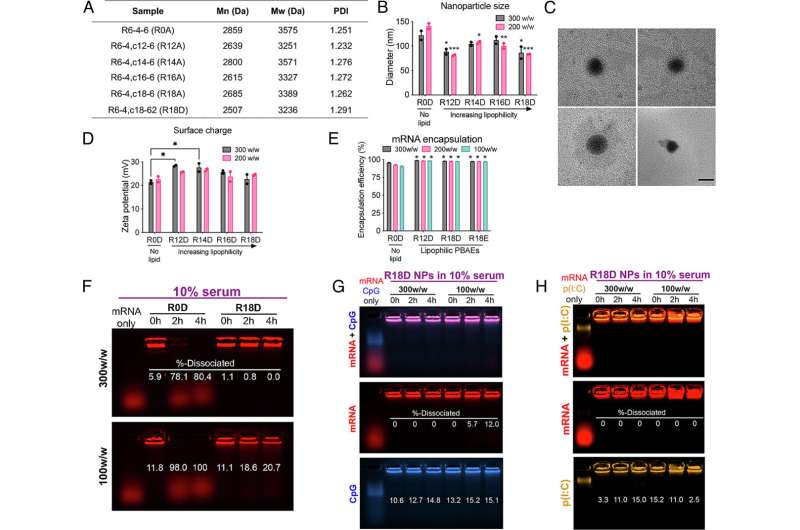This article has been reviewed according to Science X's editorial process and policies. Editors have highlighted the following attributes while ensuring the content's credibility:
fact-checked
peer-reviewed publication
trusted source
proofread
Directing vaccines to dendritic cells in preclinical cancer treatment regimen

Vaccines work by giving our immune system a 'heads up' about a known threat. They are traditionally given before we encounter a pathogen (such as the influenza virus), allowing our bodies to mount a better immune response if that pathogen is seen again. But vaccines can also be given as a treatment, after a patient has been diagnosed with a specific type of cancer.
Cancer treatment vaccines stimulate the body to recognize and attack cancer cells, which are often adept at evading the immune system. While few cancer treatment vaccines are currently used in the clinic, hundreds of clinical trials are evaluating vaccines as a potential therapeutic strategy for numerous cancer types.
Many cancer vaccines under investigation use mRNA to deliver key information to the immune system. But most of these trials do not effectively target dendritic cells, a key orchestrator of the immune response. Because dendritic cells display antigens on their surface, which activates other components of the immune system and sounds the alarm about a potential threat, they are an attractive target for cancer treatment strategies.
With the ultimate goal of developing an improved vaccine strategy, a research team at Johns Hopkins University has designed a targeted, biodegradable nanoparticle that specifically delivers mRNA to dendritic cells. When evaluated in multiple mouse tumor models, treatment with the nanoparticles provided robust antitumor activity when combined with a type of therapy called immune checkpoint blockade. Their results were recently reported in the journal PNAS.
"Decades of mRNA research led to the rapid deployment of lifesaving COVID-19 vaccines, and this platform could be applied to other health threats, including both disease prevention and treatment," said David Rampulla, Ph.D., director of the division of Discovery Science & Technology at NIBIB. "This study introduces a new biomaterial useful for mRNA delivery that specifically targets dendritic cells that could potentially enable next-generation vaccines."
Building a biodegradable nanoparticle
Instead of nanoparticles constructed from lipids, the nanoparticles used in this study are built using biodegradable plastic. "Our biomaterial is similar to biodegradable sutures (or stitches) except that they are even smaller and degrade safely even faster," explained senior study author Jordan Green, Ph.D., a professor in the Department of Biomedical Engineering at Hopkins.
"They have been designed from the ground up to be highly efficient for mRNA delivery, entering dendritic cells and quickly breaking down to safely release the mRNA in the right place and trigger an immune response."
Green and his team developed a library of polymeric nanoparticles with different chemical structures and evaluated how well they could target dendritic cells. By modifying different components of the particles—such as the hydrophobicity of molecules that branch off, and different molecules that "cap" the end of the polymer—the researchers could tweak their product's specificity. The researchers also engineered their particles to degrade in intracellular environments, facilitating cargo release once the particles travel inside cells.
To make sure that the nanoparticles effectively targeted dendritic cells, the researchers tested them in mice. They filled the particles with mRNA instructions for a fluorescent protein so that they could easily see where the nanoparticles were going. Following injection, their experiments revealed that the nanoparticles traveled to the spleen (where many immune cells reside). When the researchers teased out which specific splenic cells were being targeted, they found that the nanoparticles selectively interacted with dendritic cells more than any other cell type.
Next, the researchers evaluated their nanoparticles as part of a preclinical cancer treatment regimen. They filled their biodegradable nanoparticles with mRNA that encodes for tumor-specific antigens found in either melanoma or colon cancer. They also added an adjuvant into the nanoparticles, which helps to further stimulate the immune system (and are frequently added to vaccines). Then, along with an anticancer drug known as an immune checkpoint inhibitor, the researchers assessed their nanoparticles in mice with melanoma or colon tumors.
Compared with the immune checkpoint inhibitor alone, the combinatorial treatment with the cancer vaccine significantly decreased tumor growth and significantly increased survival in the melanoma cancer models. In the colon cancer model, the combinatorial treatment shrank tumors and improved survival, and half of the mice completely cleared their tumors and became long-term survivors. When these survivors were "rechallenged" by injection with new colon cancer cells, none developed tumors, indicating that the treatment provided their immune system with robust antigen-specific memory.
"Through careful work and engineering by our scientific team, we were able to tinker with the nanoparticle formulations to discover which chemical components enabled safe and effective delivery to dendritic cells," said Green. "While the research is still in the early stages, we found that combinatorial treatment with our dendritic-targeted nanoparticles provided significant antitumor activity in multiple models of cancer."
"Our interdisciplinary study builds on three emerging branches of therapeutics: immunotherapy, gene therapy, and nanomedicine," Green added. "We are just at the beginning of the translation of these fields, and as they mature, new clinical trials are opening exciting possibilities for patient care."
More information: Elana Ben-Akiva et al, Biodegradable lipophilic polymeric mRNA nanoparticles for ligand-free targeting of splenic dendritic cells for cancer vaccination, Proceedings of the National Academy of Sciences (2023). DOI: 10.1073/pnas.2301606120




















